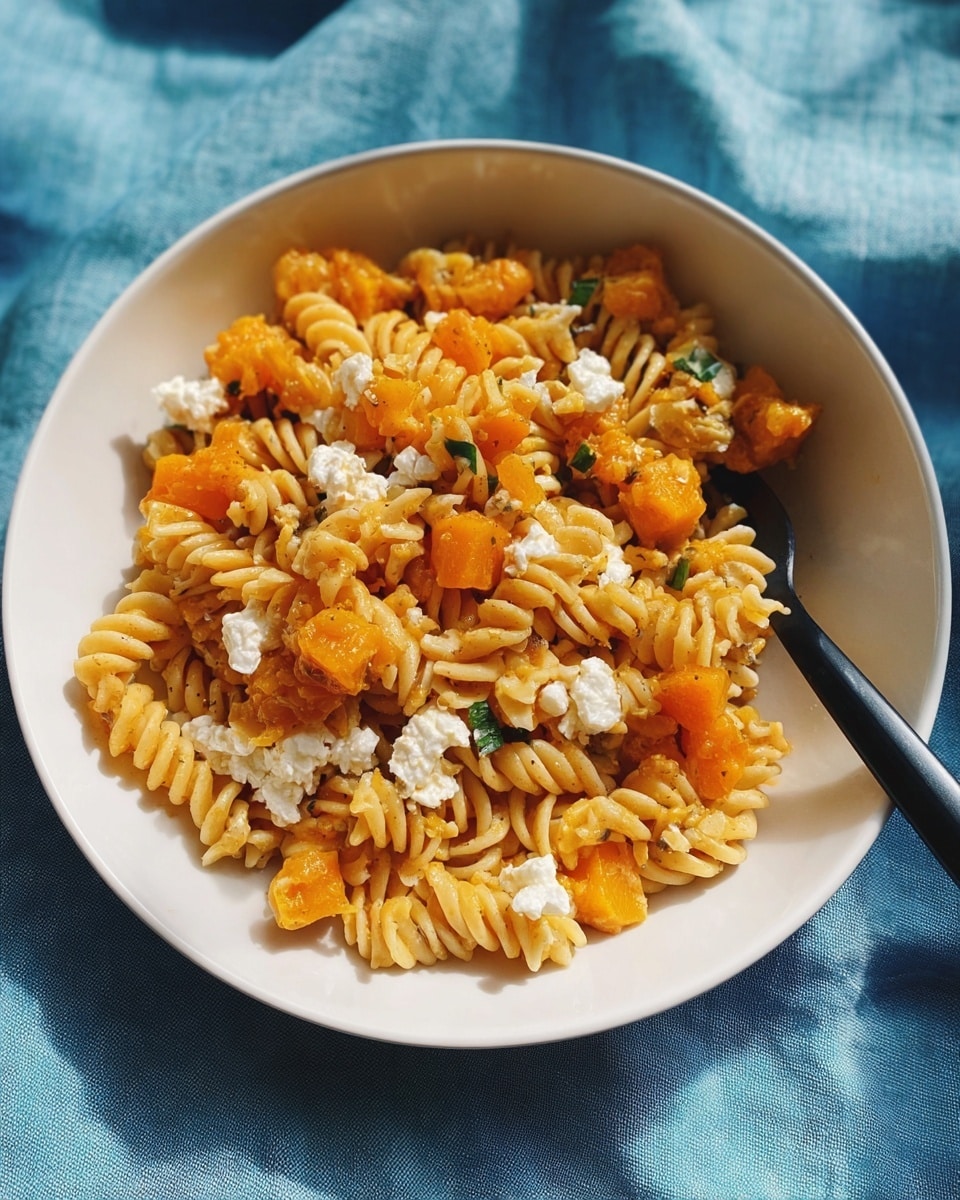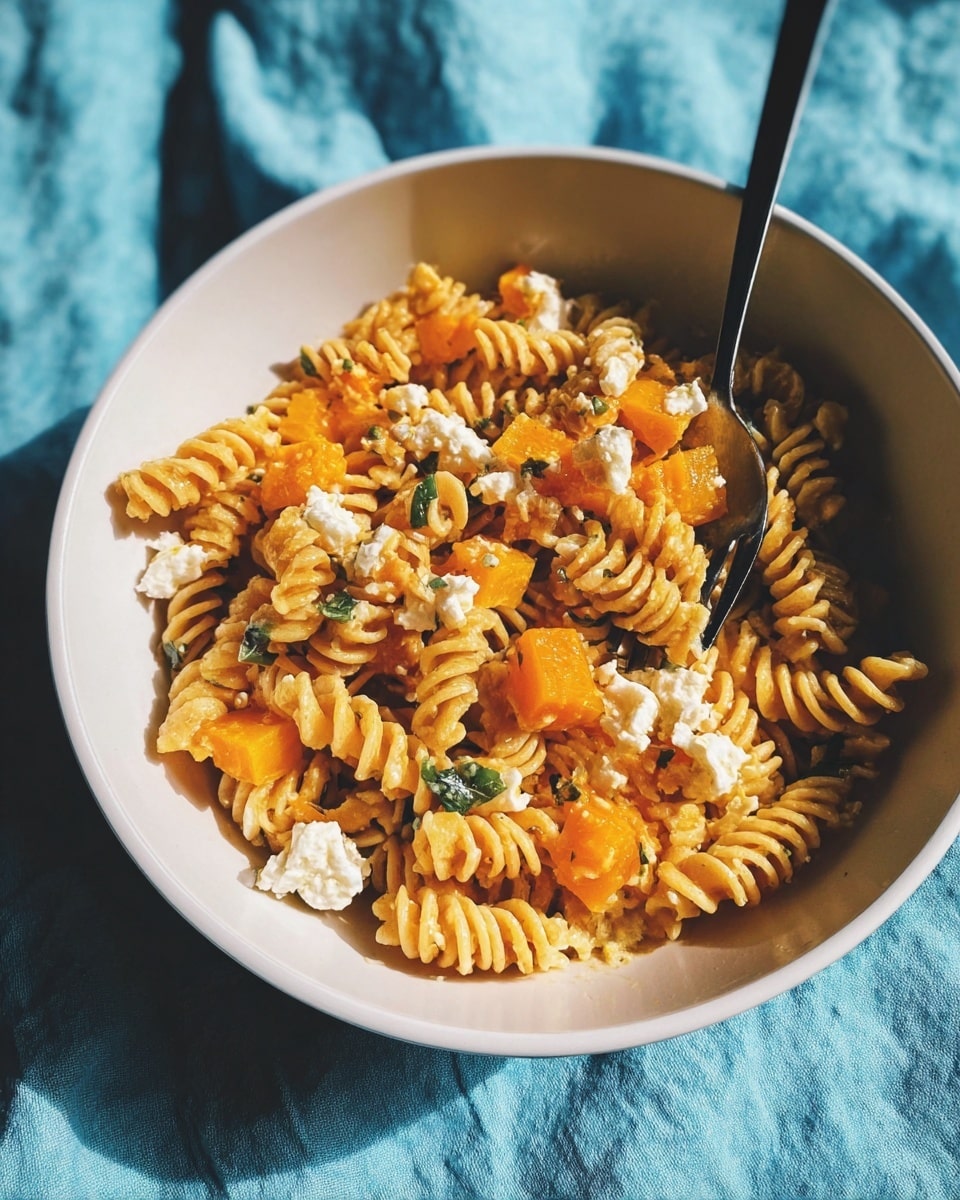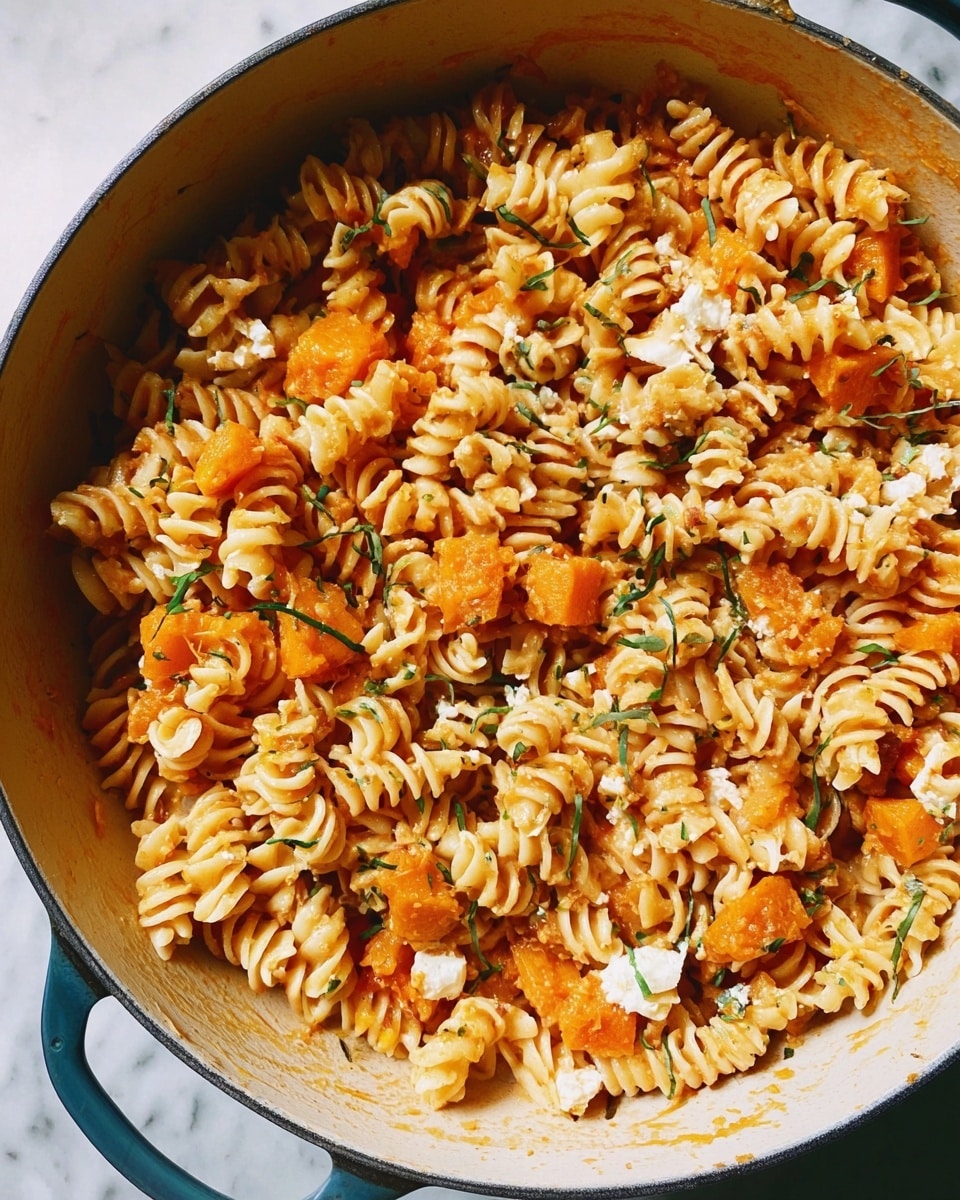I absolutely love sharing this Baked Feta and Butternut Squash Pasta with Sage and Garlic Recipe because it’s one of those dishes that feels cozy and indulgent but is surprisingly easy to pull off. When I first tried this, I was blown away by how perfectly the sweet, roasted butternut squash pairs with the salty creaminess of baked feta, and how the fresh sage and garlic lift the entire dish with a subtle earthiness. It’s a fantastic fall or winter meal, but honestly, I find myself craving it year-round because it’s so comforting and packed with flavor.
What makes this Baked Feta and Butternut Squash Pasta with Sage and Garlic Recipe a winner in my kitchen is how versatile and forgiving it is, especially if you’re someone like me who loves a fuss-free dinner. You don’t need fancy skills or complicated ingredients, just some patience while the oven does its magic. Plus, the whole meal comes together in a single baking dish with a pot of pasta, which means less cleanup—a total win, right?
Why You’ll Love This Recipe
- Easy, One-Dish Baking: You roast everything together, letting flavors blend beautifully without constant stirring or babysitting.
- Perfect Balance of Flavors: The sweet squash, salty feta, warm sage, and a touch of honey make every bite interesting and comforting.
- Great for All Skill Levels: Whether you’re a beginner or seasoned home cook, this recipe is straightforward and rewarding.
- Ideal for Busy Weeknights or Casual Dinners: It’s impressive enough for guests but cozy enough for quiet nights in.
Ingredients You’ll Need
These ingredients come together like old friends—each playing a role to build a creamy, flavorful pasta dish that’s bound to become a favorite. When shopping, look for a firm butternut squash and a good quality block of feta for the best results.
- Butternut Squash: Choose a large, firm squash with smooth skin to ensure sweetness and good roasting texture.
- Olive Oil: Use extra virgin for flavor; it helps everything roast beautifully and adds richness.
- Kosher Salt: This is my go-to for seasoning — it’s cleaner tasting and easier to manage than table salt.
- Red Pepper Flakes (optional): Add a subtle heat that wakes up the dish if you like a little kick.
- Feta Cheese Block: A good quality block yields the perfect creamy-roasted texture over crumbled feta.
- Pasta (rotini, orzo, or ditalini): I like shapes that cling to the sauce well, but you can use what you have on hand.
- Fresh Sage: Finely minced, it lends an earthy brightness that pairs wonderfully with garlic.
- Garlic: Minced cloves add the perfect savory boom at the end of roasting.
- Hot Honey (or regular honey): This balances the salty feta and earthy squash with a touch of sweetness and warmth.
- Fresh Cracked Black Pepper: Always finish with fresh pepper to amplify the dish’s flavor dimensions.
Variations
I love making this Baked Feta and Butternut Squash Pasta with Sage and Garlic Recipe my own, so don’t be afraid to switch things up to suit your taste or what’s in your pantry. Feel free to get creative — this recipe is definitely flexible and forgiving!
- Greens Addition: I often toss in fresh spinach or kale toward the end to add a pop of color and nutrients without overpowering the flavors.
- Protein Boost: Adding some crispy pancetta or toasted pine nuts gives this pasta an extra layer of texture and flavor that my family adores.
- Dietary Swaps: For a gluten-free version, I use gluten-free pasta and it comes out just as delicious!
- Herb Changes: Sometimes I swap sage for fresh thyme or rosemary depending on what I have, and it never disappoints.
How to Make Baked Feta and Butternut Squash Pasta with Sage and Garlic Recipe
Step 1: Prep and Roast the Butternut Squash and Feta
Start by preheating your oven to 400°F (about 200°C). Toss peeled and cubed butternut squash with olive oil, kosher salt, and fresh cracked pepper until well-coated. Spread it out in a baking dish and nestle an 8-ounce block of feta in the center. Drizzle the feta with olive oil, sprinkle on red pepper flakes if you like heat, and add more cracked pepper. Roast for 30 minutes — this slow baking brings out the squash’s natural sweetness and softens the feta, creating that luscious creamy texture.
Step 2: Crisp Up the Feta and Cook Pasta
After 30 minutes, carefully shift the squash around the edges a bit to make sure none is sticking or burning under. Don’t disturb the feta much — you want it to stay mostly intact. Crank your oven heat up to 450°F and roast 5–10 more minutes or until the feta develops a lovely light golden crust on top. Meanwhile, cook your pasta in well-salted boiling water until just al dente. Remember to reserve two cups of pasta water before draining — this starchy liquid is pure magic for your sauce!
Step 3: Mix in Sage, Garlic, Honey, and Pasta
The moment your feta is toasted and out of the oven, stir in freshly minced garlic, sage, and a spoonful of hot honey. The residual heat will gently mellow the garlic’s bite and infuse the mix with herbal and sweet notes. Add the drained pasta and about one cup of the reserved pasta water, stirring everything to combine. If it feels dry, add more pasta water a splash at a time until the sauce coats your pasta beautifully — creamy but not runny. Finish with more salt, pepper, and a drizzle of hot honey if you want a little extra zing.
Pro Tips for Making Baked Feta and Butternut Squash Pasta with Sage and Garlic Recipe
- Pick Ripe Butternut Squash: I learned that softer, sweeter squash makes the biggest flavor difference—avoid greenish or overly hard ones.
- Don’t Skip the Reserved Pasta Water: This starchy water is magical for turning the baked feta into a creamy sauce instead of a dry crumble.
- Control Garlic Intensity: Adding garlic right after baking lets it mellow – if it goes in too early, it can get bitter and overpowering.
- Keep an Eye on the Feta Browning: Too long in the oven and it’ll dry out; too short and you miss that tuneful caramelization — aim for light golden spots.
How to Serve Baked Feta and Butternut Squash Pasta with Sage and Garlic Recipe

Garnishes
I usually sprinkle fresh chopped parsley or more sage leaves on top for a burst of green and fresh flavor—it adds brightness and a beautiful contrast. A light drizzle of extra hot honey or a pinch of red pepper flakes on finish amps up those subtle sweet-spicy notes I love.
Side Dishes
This pasta is hearty, but I like pairing it with a crisp simple salad—something with citrus dressing or even a classic Caesar to cut through the richness. Roasted green beans or a side of garlic bread make it a full comforting meal that hits all the right notes.
Creative Ways to Present
For special dinners, I serve this pasta family-style right out of the baking dish for a rustic vibe. Another fun way is spooning it into small individual ramekins topped with toasted breadcrumbs for added crunch—your guests will think you went all out!
Make Ahead and Storage
Storing Leftovers
I store leftovers in an airtight container in the fridge and it keeps well for up to 3 days. The sauce thickens as it cools, so you might want to add a splash of water or olive oil when reheating to loosen things back up.
Freezing
I don’t usually freeze this pasta because the texture of the roasted squash changes a bit, but if you do, freeze it before mixing with pasta and fresh herbs. Thaw fully and stir in pasta freshly cooked to maintain a nice bite.
Reheating
The best way I found to reheat is gently on the stovetop over low heat with a splash of reserved pasta water or broth. This keeps the sauce creamy and prevents the feta from drying out.
FAQs
-
Can I use other types of pasta for this recipe?
Absolutely! While rotini, orzo, or ditalini are great because they hold the sauce well, you can use any pasta shape you prefer. Just keep in mind that cooking times may vary, so cook your pasta al dente to maintain the best texture.
-
Is there a substitute for fresh sage if I don’t have any?
Yes! If fresh sage isn’t available, dried sage can work in a pinch, though use less since it’s more concentrated. Alternatively, fresh thyme or rosemary can add a lovely earthy note similar to sage.
-
What if I’m not a fan of spicy food—can I skip the red pepper flakes and hot honey?
Definitely! You can leave out the red pepper flakes and use regular honey instead of hot honey. The dish will still be deliciously rich and flavorful but without the heat.
-
How do I know when the feta is perfectly baked?
Look for a lightly golden brown crust on the top of the feta after the final roasting step. It should be soft and creamy inside but with just a bit of color on top. Avoid letting it over-brown or dry out by keeping a close eye during the last 5-10 minutes in the hotter oven.
Final Thoughts
This Baked Feta and Butternut Squash Pasta with Sage and Garlic Recipe has become one of those dishes that feels like a warm hug on a plate. I love how simple it is yet how many layers of flavor you get without fussing over complicated technique. I know you’ll enjoy making and sharing it as much as I do — it’s one of those recipes you’ll come back to again and again, whether for a cozy family meal or impressing friends with minimal effort. Give it a try, and let me know how it becomes your new favorite!
Print
Baked Feta and Butternut Squash Pasta with Sage and Garlic Recipe
- Prep Time: 10 minutes
- Cook Time: 40 minutes
- Total Time: 50 minutes
- Yield: 4 servings 1x
- Category: Main Course
- Method: Baking
- Cuisine: Mediterranean
- Diet: Vegetarian
Description
A delicious and comforting baked feta and butternut squash pasta dish featuring roasted butternut squash, creamy baked feta cheese, fragrant sage, garlic, and a touch of hot honey for a perfect balance of savory and sweet flavors.
Ingredients
Butternut Squash and Feta Mixture
- 5 cups Butternut Squash (about 1 large butternut squash)
- 1/2 cup Olive Oil plus more for drizzling
- 2 hefty pinches Kosher Salt (just shy of 1/2 tsp)
- 1 hefty pinch Red Pepper Flakes (optional)
- 1 8 oz block Feta Cheese
- Fresh Cracked Black Pepper (to taste)
Pasta and Flavorings
- 1 lb Pasta (such as rotini, orzo, or ditalini)
- 10 leaves Fresh Sage, minced
- 3 cloves Garlic, finely minced
- 1 tablespoon Hot Honey (regular honey can be used)
Instructions
- Preheat Oven: Preheat your oven to 400°F (200°C) to prepare for roasting the butternut squash and baking the feta cheese.
- Toss and Arrange Butternut Squash and Feta: In a bowl, toss the butternut squash cubes with ½ cup olive oil, 2 hefty pinches of kosher salt, and freshly cracked black pepper. Place the seasoned squash in a baking dish and set the 8 oz block of feta cheese in the center. Drizzle the feta with a little olive oil, sprinkle red pepper flakes if using, and add more cracked black pepper for seasoning.
- Bake at 400°F: Bake the dish in the preheated oven for 30 minutes to roast the squash and begin softening the feta.
- Adjust and Increase Temperature: After 30 minutes, remove the dish from the oven and gently move the butternut squash to prevent burning on the bottom—be careful not to touch the feta. Increase the oven temperature to 450°F (230°C) and bake for an additional 5 to 10 minutes, or until the feta starts to brown slightly.
- Cook Pasta: Meanwhile, bring a large pot of salted water to a boil. Cook the pasta until al dente according to package instructions. Reserve 2 cups of pasta water before draining the pasta.
- Add Flavorings and Combine: Once the feta and squash are baked and browned, remove the baking dish from the oven. Immediately add the minced garlic, minced fresh sage, and hot honey to the warm feta mixture. Then add the cooked pasta along with 1 cup of reserved pasta water. Stir to combine everything smoothly.
- Adjust Sauce Consistency and Season: If the pasta seems dry, gradually add the remaining reserved pasta water little by little until the sauce becomes creamy and smooth. Taste and season the dish further with more salt, cracked black pepper, or hot honey as desired.
Notes
- Use red pepper flakes sparingly or omit if you prefer less heat.
- Hot honey adds a lovely spicy-sweet contrast but regular honey works fine if preferred.
- Be gentle when moving the squash after the initial bake to avoid breaking the block of feta.
- Reserve pasta water as its starchiness helps create a creamy sauce consistency.
- Any short pasta like rotini, orzo, or ditalini works well for this recipe.
Nutrition
- Serving Size: 1 cup
- Calories: 420
- Sugar: 5g
- Sodium: 670mg
- Fat: 18g
- Saturated Fat: 6g
- Unsaturated Fat: 10g
- Trans Fat: 0g
- Carbohydrates: 48g
- Fiber: 5g
- Protein: 14g
- Cholesterol: 25mg



